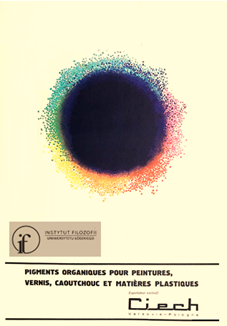
written by Jowita Mróz (02.07.2020)
translated by the Editorial Team (03.04.2021)
Before the political transformation in Poland CIECH – Import-Export Centre for Chemicals – was a giant in sale of chemical raw materials used in the production of glass, soda ash, nitrogen fertilizers, cosmetics, varnishes, paints and other products used in agriculture, construction and glass production. It has even become a kind of monopolist that supplying crude oil to the Polish refineries.
The achievements of CIECH called for an accurate visual message. Karol Śliwka (also Hubert Hilscher, Witold Janowski, Jerzy Treutler) came to the rescue. The author of the “piggy bank” PKO (1968) was also famous for the graphic sign of the “Uroda” Warsaw Soap and Cosmetics Factory (1967), that is “just with a lady with a fox around her neck”1 and the mother’s heart of the emblem of the Institute of Mother and Child (1980). He effectively refreshed the perspective of the viewers in the communist era. Not without a reason his works are considered as iconic today. In his works familiar looking, simple and artfully combined graphic elements and witty used everyday objects played the role of a narrator of a visual fascinating stories. Śliwka proved that there is no too complicated and earthbound topic, and even the sole of the Chełmek Shoe Factory (1967) may become the hero of the visual anecdote.
The poster of CIECH, as well as the graphic signs designed for the company (1967/1968), is a skillfully constructed visual cipher, the breaking of which provides a heuristic pleasure. Information about the specificity of the CIECH company does not appear in the form of a catchy slogan or in the form of an allusion to the viewer’s everyday experience. It hides in an unobvious shape that evoking associations with the structure of some organic chemical compound. Shape? Figure? Stain? – arouses curiosity of the viewer; plays with him, balancing between depth, heaviness and seriousness of the black in the center and expressiveness, dynamics and energy of colorful particles located on the edges as if they were splashed paint. It works on the viewer’s eye as the most eye-catching op-art works. In a suggestive, but non-aggressive way, the main and at the same time the only graphic element of the poster informs about unrivalled, even monopolistic position of CIECH in the chemical industry, its strength connected with creativity, reliability and energy.
The poster of CIECH brings to mind Śliwka’s self-ironic personal sign (1970). In the 1980s the sign was enriched with a black and white half-profile portrait of the author and his signature. Perhaps the earliest variation of a similar form is a cover of the “Exportador de Polonia” 1967, nr 6(88)2.
1 Karol Śliwka’s comment in: Karol Śliwka, ed. ed. Agata Abramowicz, Agnieszka Drączkowska, Jacek Friedrich, Patryk Hardziej, the Gdynia City Museum, Gdynia 2019, p. 94.
2 Ibid., p. 132.
